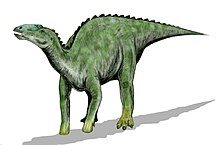Hadrosauridae
| Hadrosauridae | ||||||||||||
|---|---|---|---|---|---|---|---|---|---|---|---|---|

Hadrosaurs of undetermined genus, drawn by Heinrich Harder in 1916 |
||||||||||||
| Temporal occurrence | ||||||||||||
| Upper Cretaceous ( Cenomanian to Maastrichtian ) | ||||||||||||
| 100.5 to 66 million years | ||||||||||||
| Locations | ||||||||||||
| Systematics | ||||||||||||
|
||||||||||||
| Scientific name | ||||||||||||
| Hadrosauridae | ||||||||||||
| Cope , 1869 |
The Hadrosauridae , also known as "hadrosaurs" or "duck-billed dinosaurs", are a systematic group ( taxon ) of herbivorous bird pelvic dinosaurs from the late Cretaceous period . They were among the most successful dinosaurs: around 35 genera have been identified to date .
morphology
General
Hadrosaurs had widened and flattened snouts (similar to duckbills, hence the German name) with horn edges. Their teeth were very similar to iguanodonts , but they had more individual teeth per row of teeth, and each tooth position had a magazine of five replacement teeth. This made a long, narrow secondary chewing surface possible, which, in conjunction with special grinding movements, guaranteed good chewing of the plant food. The hind legs were very well developed, but hadrosaurs probably showed a great tendency to quadruped (four-legged) locomotion. They only walked biped on their hind legs when running fast during the escape.
The hadrosaurs probably grew at a rate similar to that of today's large mammals. The genus Maiasaura peeblesorum had reached its full size in six to eight years.
In 1999, the fossilized mummy (" Dakota ") of an Edmontosaurus was found in the Hell Creek Formation in the US state of North Dakota . The excellent state of preservation helped to fundamentally new knowledge about the soft tissue anatomy (skin, muscles) and biology of the dinosaurs.
Lambeosaur skull
The lambeosaurs differed from other hadrosaurs especially in the structure of the skull: They had tubular, comb-like structures, which were formed from premaxillaries and nasalia. They were probably used to produce trumpet-like sounds. The size dimorphism of the “trumpet” between the sexes suggests that it played a role in courtship behavior.
Way of life
Much more is known about the way of life of hadrosaurs than about other dinosaurs due to good findings. They probably lived in large groups and showed a social behavior that resembled that of today's ungulates. One is well informed about the diet of hadrosaurs through an Anatosaurus find, which is exhibited today in the Frankfurt Senckenberg Museum: Large quantities of conifer needles were found in its stomach.
Systematics
Hadrosaurs are the phylogenetically most highly developed ornithopods and form a sister group of the Iguanodonta. They do not derive from each other, this is proven by many parallels in physique. According to the body structure of the hadrosaur Camptosaurus prestwichi from the Kimmeridgian, it is assumed that the hadrosaurs had split off at this point in time. In all probability, Cedrorestes is the oldest hadrosaur that lived in Spain about 130 million years ago. This implies a paleogeographical distribution pattern, according to which Iguanodontids had not yet colonized Asia before the Cretaceous. This is where the hadrosaurs evolved.
However, this thesis does not fit perfectly with other evidence, such as fossils in the Jura of China. Clearly defined hadrosaurs, including Gilmoreosaurus and Bactrosaurus, are only known from the Upper Cretaceous. The hadrosaurs, which in their morphology most resemble the Iguanodontids, are Probactrosaurus and Ouranosaurus .
The monophyly of the hadrosaurs is currently hardly in doubt due to many autapomorphies.
Taxa include:
- Hadrosauridae
swell
literature
- John R. Horner, David B. Weishampel, and Catherine A. Forster: Hadrosauridae : In; D. Weishampel, P. Dodson and H. Osmólska (Eds.): The Dinosauria . University of California Press, 2004, ISBN 0-520-24209-2 , pp. 494-513
- Reinhard Rieger and Wilfried Westheide (eds.): Special zoology. Part 2: vertebrates or skulls. Gustav Fischer Verlag, Stuttgart Jena & New York 2003, ISBN 3-8274-0900-4 , p. 400 f.
- Hartmut Haubold: Die Dinosaurier , Die neue Brehm-Bücherei 432, Westarp Wissenschaften, Ziemsen & Wittenberg Lutherstadt 1990, 4th edition, pp. 86-92, ISBN 3-7403-0170-8
Web links
- Hadrosauridae near Palaeos
Individual evidence
- ^ Gregory S. Paul: The Princeton Field Guide To Dinosaurs. Princeton University Press, 2010. ISBN 978-0-691-13720-9 , pp. 293-316
- ^ According to Rieger & Westheide (2003), p. 401
- ^ Thesis based on Milner & Norman (1984), cited in Haubold (1990), pp. 86 + 87
- ^ According to Brett-Surman (1979), cited in Haubold (1990), p. 87
- ↑ According to Sereno (1986), cited in Haubold (1990), p. 87
- ↑ Elizabeth A. Freedman Fowler, John R. Horner. A New Brachylophosaurin Hadrosaur (Dinosauria: Ornithischia) with an Intermediate Nasal Crest from the Campanian Judith River Formation of Northcentral Montana. PLOS ONE, 2015; 10 (11): e0141304 doi: 10.1371 / journal.pone.0141304
- ↑ Hirotsugu Mori, Patrick Druckermiller, Gregory Erickson. A new Arctic hadrosaurid (Dinosauria: Hadrosauridae) from the Prince Creek Formation (lower Maastrichtian) of northern Alaska. Acta Palaeontologica Polonica, 2016; 61 doi: 10.4202 / app.00152.2015




